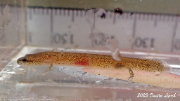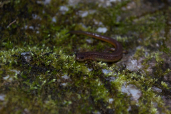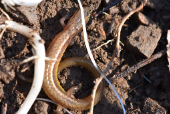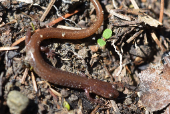Many-Ribbed Salamander (Eurycea multiplicata)
Description: The Many-Ribbed Salamander is only 2 to 3 inches long. There is a broad brown stripe running from the head down the back. The back may have small dark brown chevrons marking the medial grooves on the back. The animal's belly is pale gray to lemon yellow.
Habitat: This species inhabits cool, moist habitats near water in association with springs and permanent streams. During drier periods it can be found in the wetter portions of those streams. Individuals are often found under stones, logs, and other large cover objects in streams and springs. They are found under cover in both open areas and within the twilight zone of caves. In wet weather, this species disperses into wooded, terrestrial habitats. Larvae develop in streams, and eggs are laid on the undersides of rocks in cave streams and springs. This species appears to be tolerant of habitat disturbance, as it has been found in numerous settings including on development properties.
Range: It is endemic in its distribution to eastern Oklahoma, southwestern Missouri, and northwestern Arkansas.
Found in these States:
AR |
MO |
OK
Diet: Undescribed, but adults likely feed on a variety of aquatic and semi-aquatic vertebrates associated with springs and permanent streams. The diet of neotenic adults likely resembles that of larvae, although adults, being larger, may take larger prey.
Reproduction: Reproduction is aquatic and long-distance migrations unlikely. Populations that inhabit thermally stable springs have a prolonged mating season compared with populations inhabiting surface streams with more variable temperatures. Based on the times when females contained spermatozoa in their reproductive tracts, mating activity could be from July to May.
Status: Listed as Least Concern in view of its wide distribution, presumed large population, and because it is unlikely to be declining fast enough to qualify for listing in a more threatened category.
»» Kingdom: Animalia - Animals
»» Phylum: Chordata - Chordates
»» Subphylum: Vertebrata - Vertebrates
»» Class: Amphibia - (Amphibians)
»» Order: Caudata - Salamanders
»» Family: Plethodontidae - Lungless Salamanders
»» Genus: Eurycea
»» Species: Eurycea multiplicata - Many-Ribbed Salamander
This article uses material from the Wikipedia article "Many-Ribbed Salamander", which is released under the Creative Commons Attribution-Share-Alike License 3.0. Content may have been omitted from the original, but no content has been changed or extended.
|













